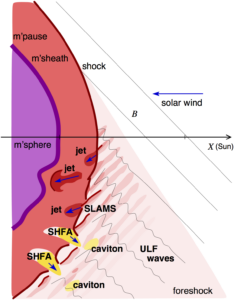 The foreshock is a disturbed region upstream of supercritical shocks, formed by the interaction of reflected particles and the incident plasma. Foreshocks can strongly affect particle acceleration, and modify the solar wind before its interaction with magnetospheres or ionospheres downstream of the shock.
The foreshock is a disturbed region upstream of supercritical shocks, formed by the interaction of reflected particles and the incident plasma. Foreshocks can strongly affect particle acceleration, and modify the solar wind before its interaction with magnetospheres or ionospheres downstream of the shock.
The research activities focusing on shocks near the Sun, Earth, and other planets have been the efforts of rather unconnected groups. Consequently, a systematic organization of the data obtained so far is lacking, which is why the following science question is still unsolved: How do foreshock processes change with system properties and upstream plasma parameters, across the solar system?
In order to answer this question, we have collected a team of top-tier researchers within the field of shock and foreshock physics, active within different solar system environments. Together the team has the required comprehensive and complementary resources, including both readily available event lists and simulations. A systematic reorganization using the terrestrial foreshock as a benchmark (Figure 1) will enable us to disentangle interlinked dependencies between the system properties and upstream parameters, revealing their relative importance and universal trends.
A comprehensive investigation of foreshock processes provides a strong test of our current understanding, as well as predictions for shocks at objects currently beyond reach (such as exoplanets and astrophysical shocks). The timeliness of the proposal is underpinned by new data from the Jovian bow shock by Juno; the upcoming novel Parker Solar Probe observations of coronal shocks and interplanetary shocks close to the Sun; and the preparations for Solar Orbiter and BebiColombo.
